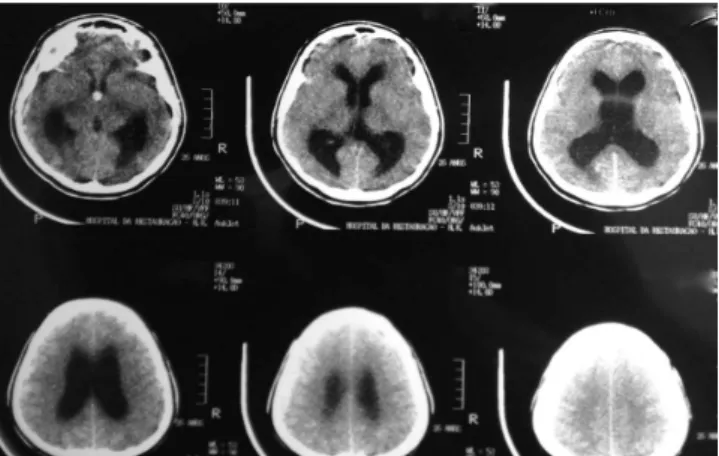311
LETTERS
Sudden death in a patient with a third
ventricle colloid cyst
Morte súbita em paciente com cisto coloide de terceiro ventrículo
Danilo Silva1,2, Georgios Matis1, Olga Chrysou3, Eduardo V. de Carvalho Junior2, Leonardo Costa2, Matheus
Kitamura2, Theodossios Birbilis3, Hildo Azevedo Filho2
1 Neurosurgical Department, Weill Cornell Medical College, New York NY, USA;
2 Neurosurgical Department, Restauração Hospital, Recife PE, Brazil;
3 Neurosurgical Department, Democritus University of Thrace Medical School, Alexandroupolis, Greece.
Correspondence: Danilo Silva; Weill Cornell Medical College, New York NY, USA; Department of Neurological Surgery; Skull base fellow; 124 west 60th street Apt 37L; New York NY - USA; E-mail: daniloncr@gmail.com
Conflict of interest: There is no conflict of interest to declare.
Received 21 October 2011; Received in final form 09 November 2011; Accepted 16 November 2011
A 26-year-old female was brought to the Emergency Department for experiencing a sudden and progressive worsen-ing of cephalalgia after sexual intercourse. She eventually became drowsy and not responsive to verbal commands. he patient had a medical history of third ventricle colloid cyst (CC), diagnosed in another institution, and had sufered intermittent headaches for two years.
he neurological examination revealed a patient in profound coma with a Glasgow Coma Scale score (GCS) of 3. Her pupils were bilaterally dilated, with no response to light stimulus. After emergency protocol procedures, the patient was admitted to the Intensive Care Unit (ICU) and a head computed tomography (CT) was obtained. he CT demonstrated hydrocephalus and a hyper-dense lesion inside the third ventricle compatible with a previous-ly known third ventricle CC (Fig 1 and 2). Due to the poor neu-rological status, no treatment was recommended and the patient
died two hours after admission. Institutional ethics committee ap-proval was obtained in order to proceed with this case report.
his is one of the very few cases of sudden death related to a third ventricle CC reported in the literature1-4. CCs are regarded as
benign lesions1, accounting for 0.5 to 2% of intracranial tumours2.
he cause of death is believed to be the result of acute cyst swelling due to an intralesional haemorrhage3,4. Its incidence varies from 1
to 3/106 person-years5,6. Estimates of the risk of acute deterioration
in patients harboring these cysts vary from 6 to 45% with episodic headache and compromised consciousness, being the most com-mon symptom and sign, respectively5. his leads to cerebral
herni-ation as a result of ventricular obstruction after blockage of Monro’s foramen1,5,6. Since cyst size, duration of symptoms, and presence of
hydrocephalus cannot reliably predict the risk of sudden neurolog-ical deterioration5, surgical management is favored, even when the
relationship between the CC and headache is unclear5,6.
Fig 1. Computed tomography scan demonstrating increased intracranial pressure due to non-communicating hydrocephalus.
Fig 2. Computed tomography scan illustrating a lesion compatible with a third ventricle colloid cyst.
References
1. Godano U, Ferrai R, Meleddu V, Bellinzona M. Hemorrhagic colloid cyst with sudden coma. Minim Invasive Neurosurg 2010;53:273-274.
2. Hadar EJ, Schmunk GA, Salamat MS. Hemorrhagic colloid cyst in a patient with leukemia. Case illustration. J Neurosurg 1999;91:516.
3. Malk GM, Horoupian DS, Boulos RS. Hemorrhagic (colloid) cyst of the third ventricle and episodic neurologic deficits. Surg Neurol 1980;13:73-77.
4. Beems T, Menovsky T, Lammens M. Hemorrhagic colloid cyst: case report and review of the literature. Surg Neurol 2006;65:84-86.
5. De Witt Hamer PC, Verstegen MJT, de Haan RJ, et al. High risk of acute deterioration in patients harboring symptomatic colloid cysts of the third ventricle. J Neurosurg 2002;96:1041-1045.
